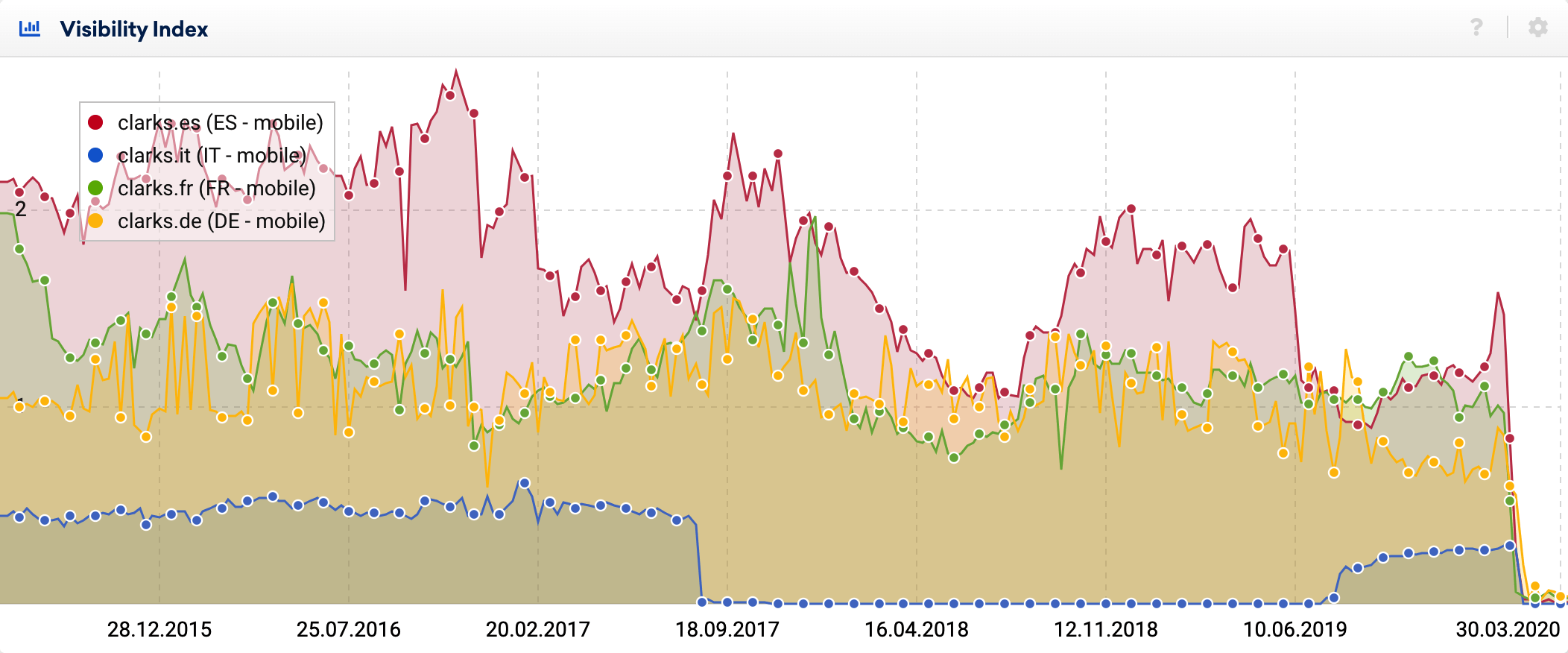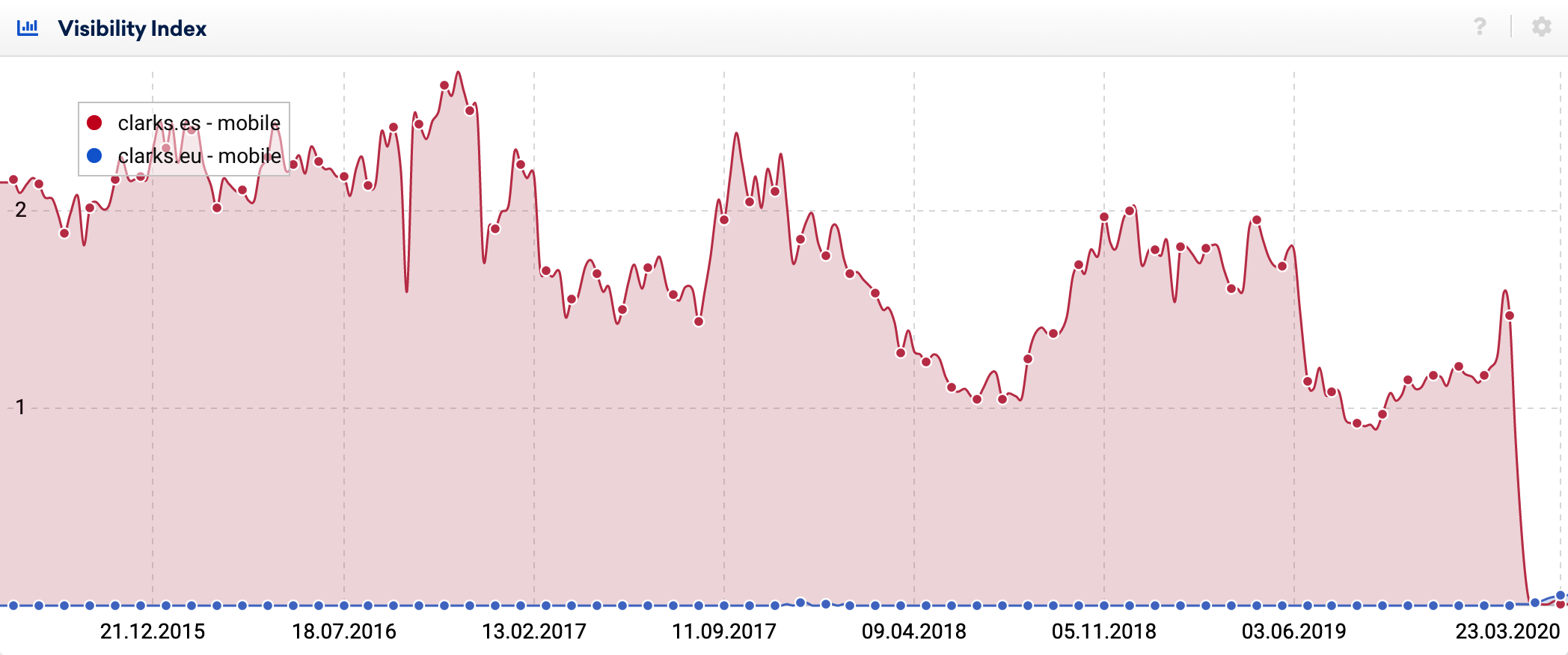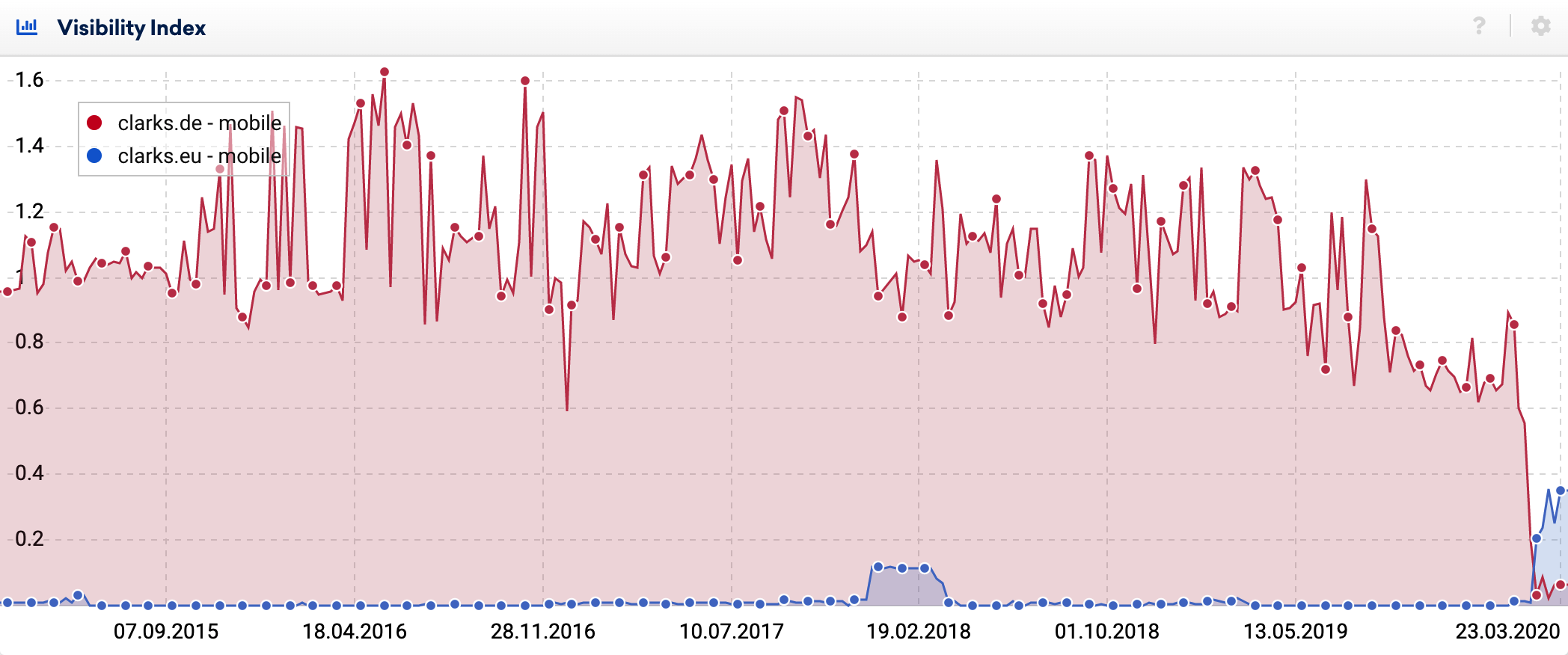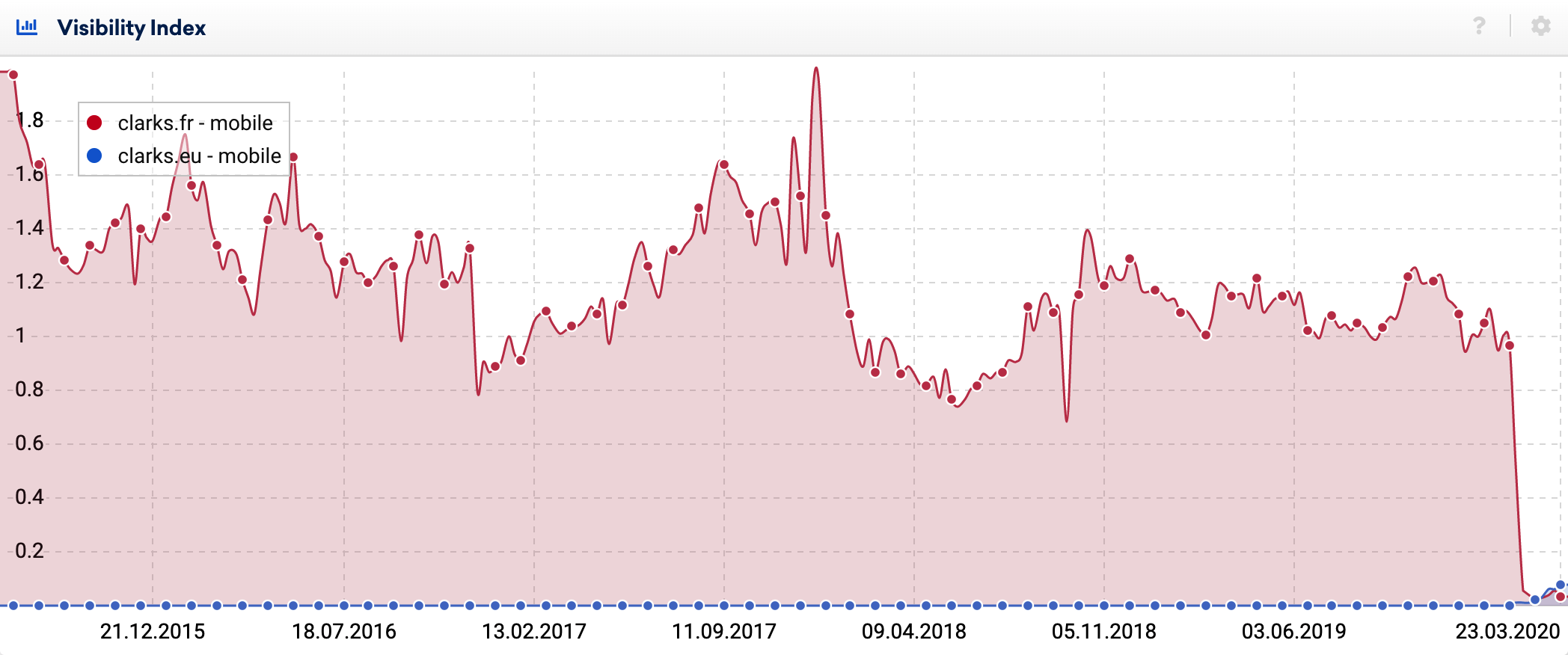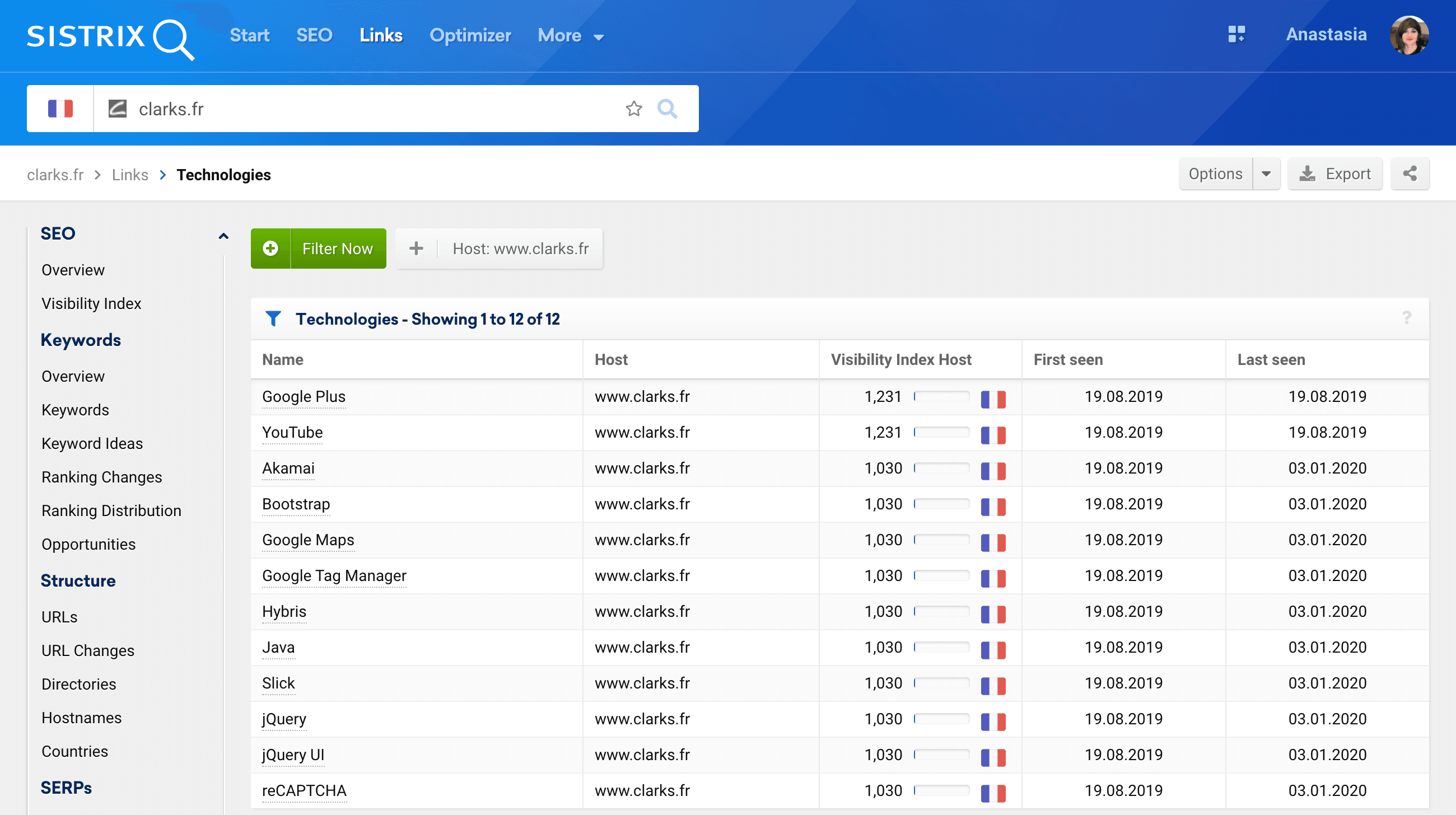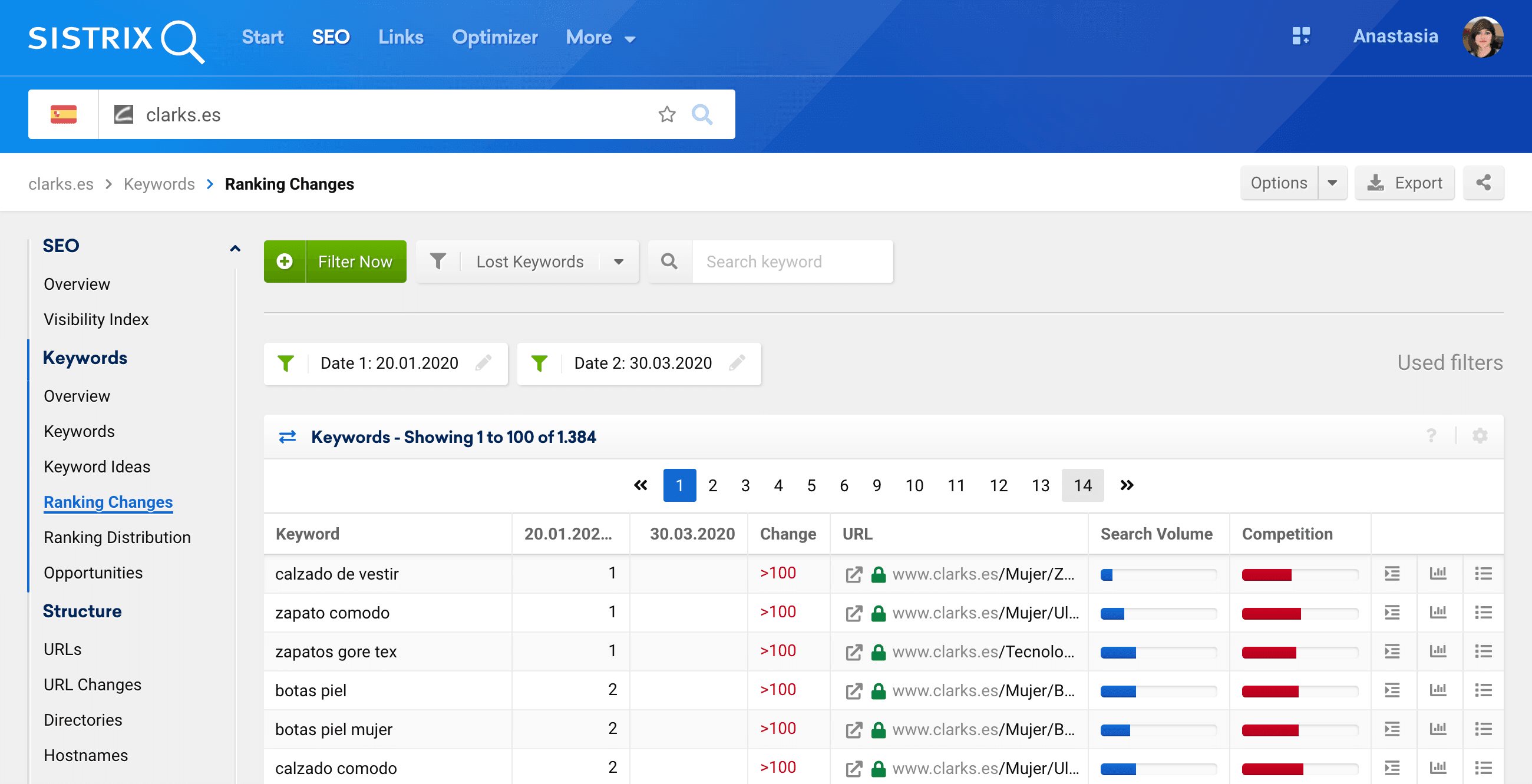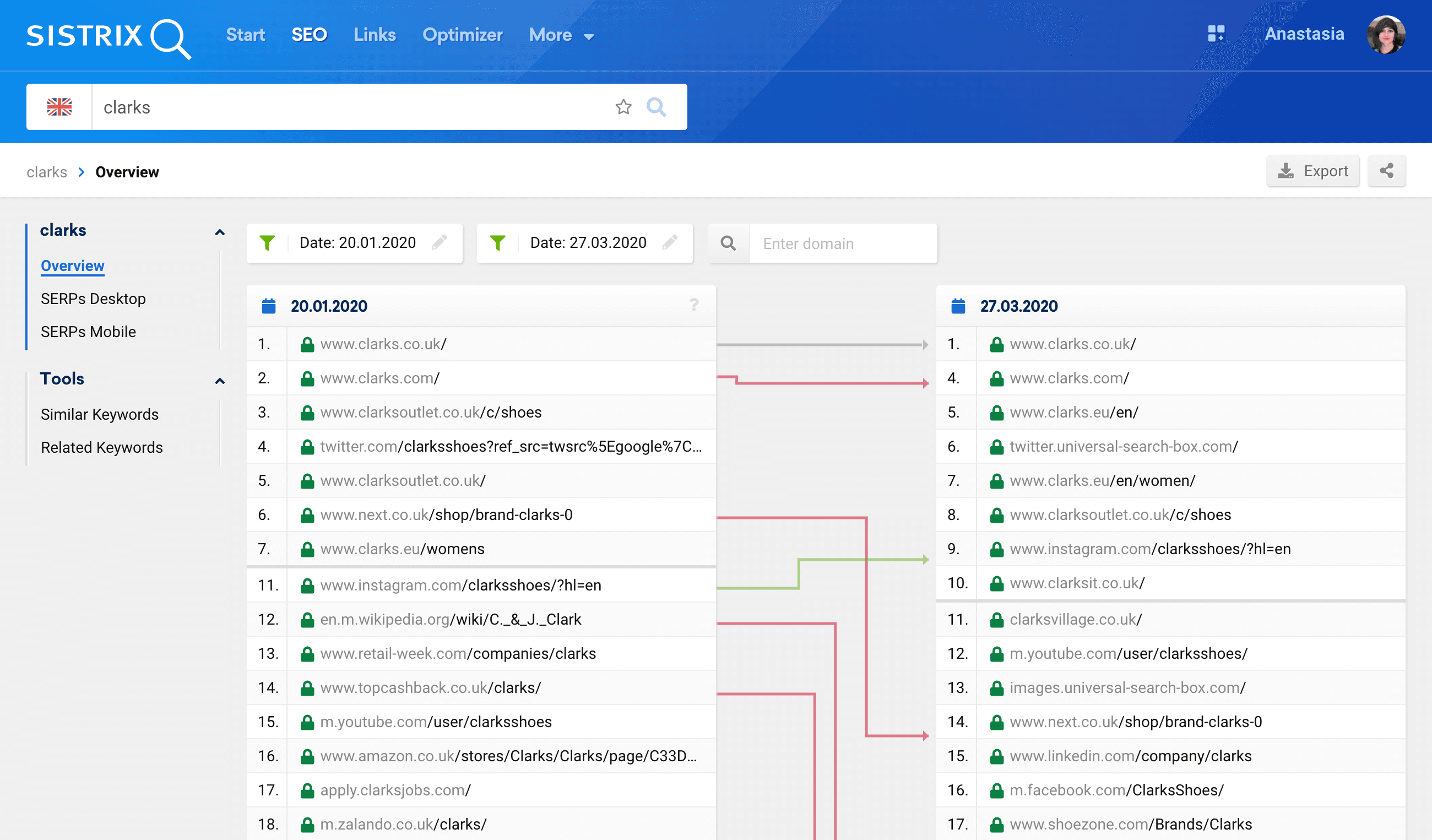In this article we are going to examine the search visibility drop of a well-known, international brand. Since January 2020, the domains for Clarks the shoemakers, have lost a large portion of their visibility in Google search. Our analysis takes a a constructive look at what happened and what SEOs can learn for their next international domain migration project.
Note: This article is from 2020.
The Clarks brand suffered a large drop in visibility at the end of January, as a result of a consolidation from country domains to directories inside clarks.eu. Here’s a summary graph for the ES, IT, FR and DE country level domains.
In this analysis we’ll also look at the local UK domain (clarks.co.uk), as well as the company-level domain (clarks.com) but first, here are the details for the country websites we’ve studied and the results of the move to the .eu domain. Following that, our analysis of the historical data, and what is tells us about the move.
Visibility in Spain
The domain migration took place around the 20th January, and the new website doesn’t inherit all the visibility gained by the previous website, as shown in the image below. It’s gone from 1.579 to 0.050 points (almost 97% less visibility).
Visibility in Germany
Between the 20th and 27th January we can see a visibility decline as a result of a domain change, and the new website begins to inherit the visibility of the old one, as shown in the image below. It dropped from 0.895 to 0.350 points (almost 61% less).
Visibility in France
Starting on 20th January, the domain change takes place, and, once again, the new website doesn’t retain the old domain’s visibility, as shown in the screenshot below. It’s gone from 1.009 to 0.080 points (almost 92% less).
Visibility in Italy
In the case of Italy, we’ve discovered that both websites coexisted since 2017, but if we use 10th February as a point of reference, clarks.it had a visibility score of 0.279 and clarks.eu 0.168. Today, the clarks.eu domain has reached a visibility score of 0.205.
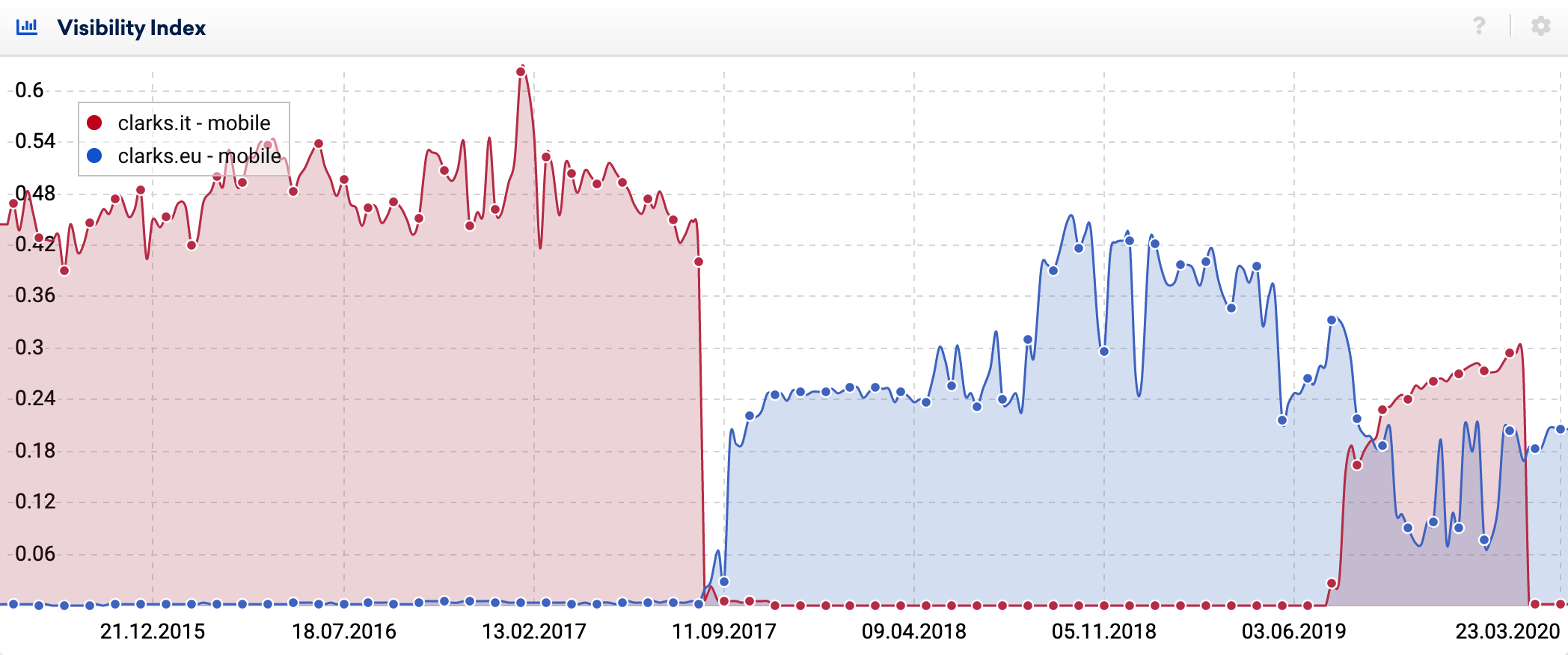
Historical analysis
Clarks is a UK brand which has managed to expand to more than 35 countries. We can see that on clarks.com, the corporate site, where franchise opportunities and job offers are advertised, in addition to indicating markets in which they are currently present.
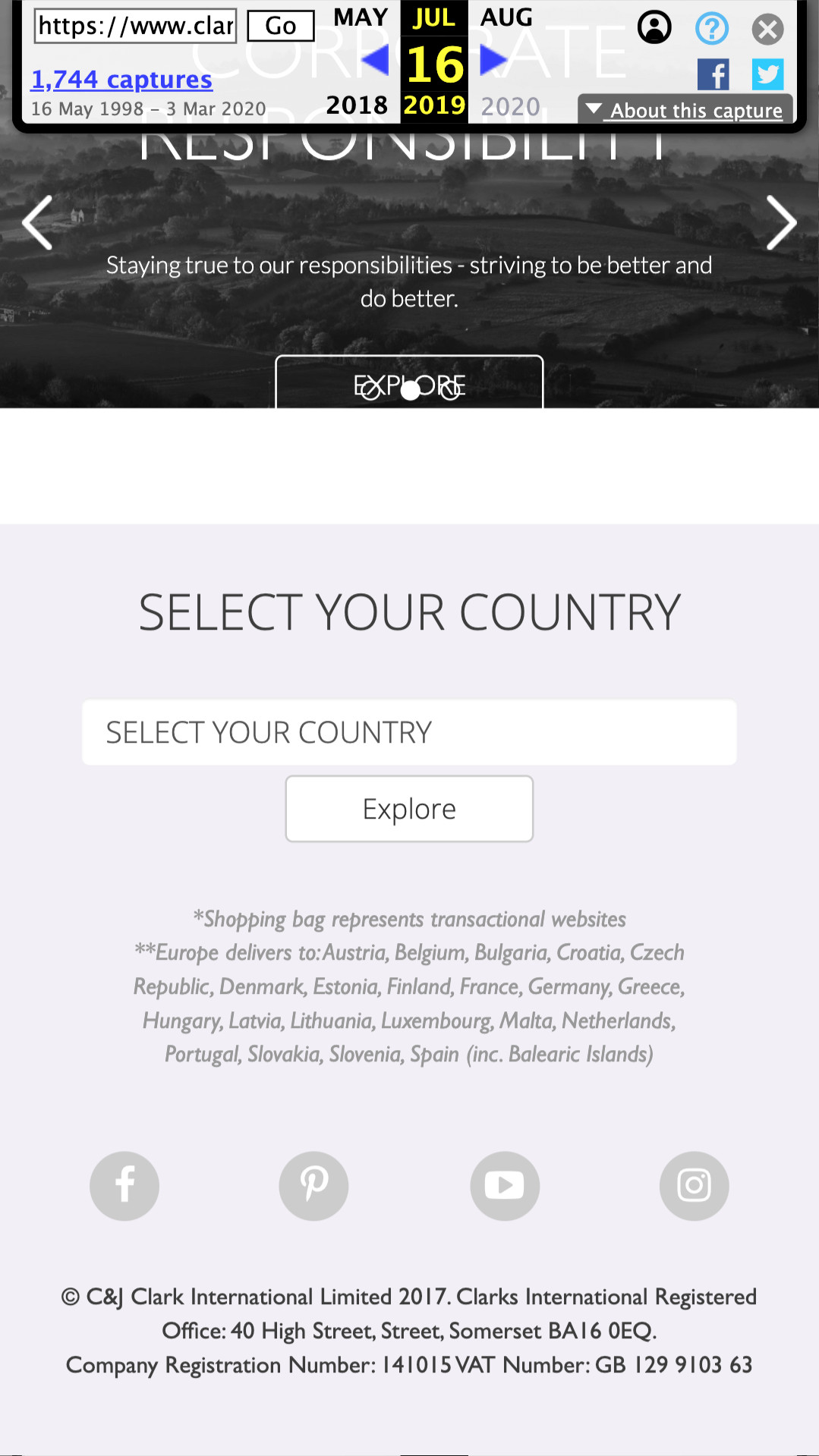
These links were already there before the migration, with links to URLs of each store in each market, acting as a flag “selector“, only without the flags!
As for the technology used, most of Clarks local websites analysed in this post were using SAP Hybris.
With the SISTRIX Technology identification feature in the Link module you can now see which technologies were used before a migration on any domain and any market, by browsing the dates to see when they stopped using a particular technology in favour of using another one.
We can see they used IP geographical data on entering the website, which can trigger a suggestion to take you to the country relating to your IP location. Luckily for the user (and for Google) it provided links, so you can choose to go or stay.

Another noteworthy aspect is that on each local website the primary markets were already linked, to give users the possibility of switching to a different store, on the top-left corner of the interface, which in terms of user experience promotes one of the core principles promoted by Jakob Nielsen: user control and freedom.
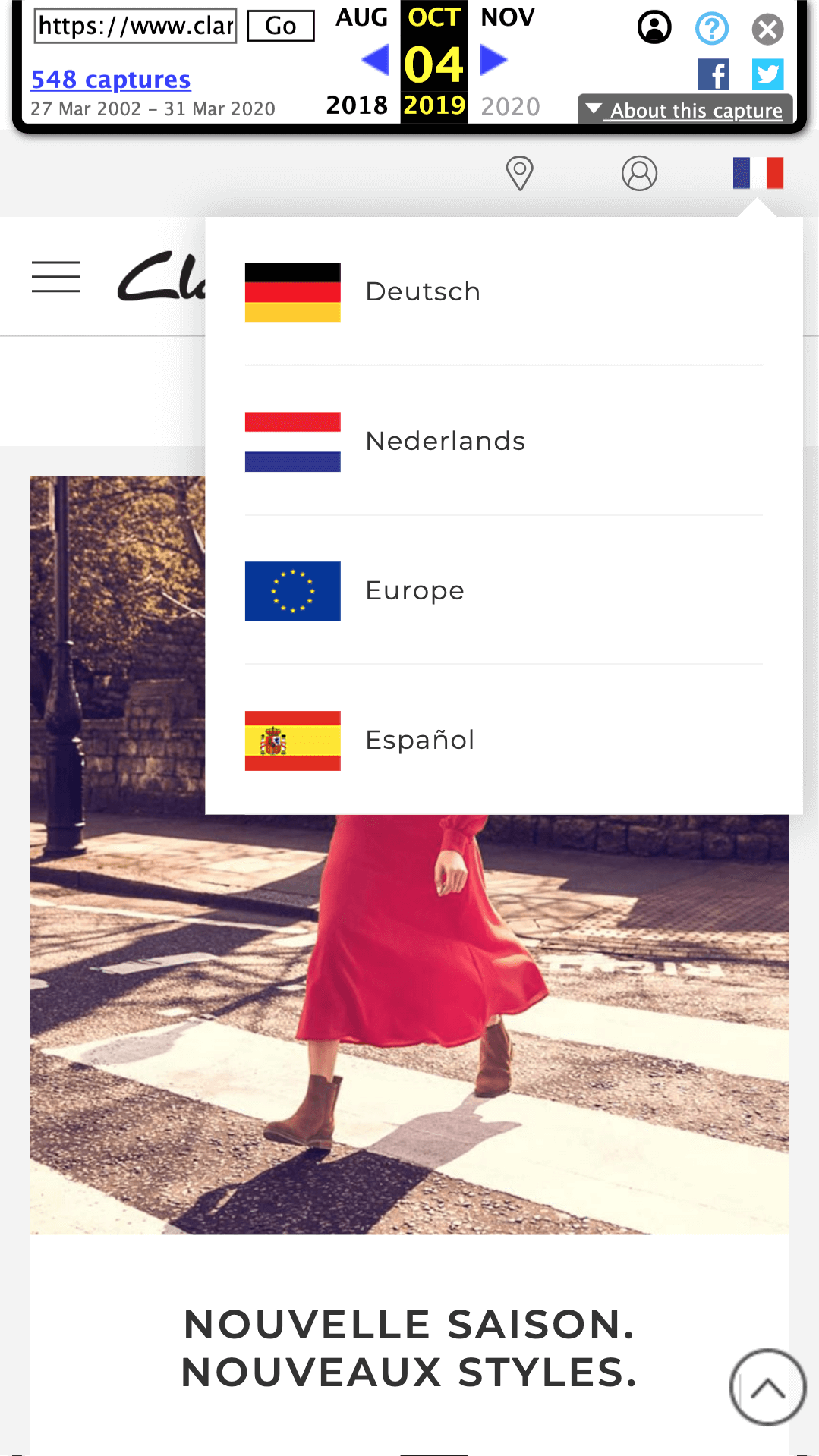
If we look at the website’s international SEO tagging, namely use of hreflang tags, we didn’t find them either in the HTML, or the HTTP headers or sitemaps.
Migration risks: visibility loss
What have we identified in the case of Clarks? Detailed below are the main issues detected that impact several of the similar stores that have experienced visibility loss.
Redirects
As we said at the beginning of this post, Clarks moved its local country domains to a .eu domain, placing each market in a folder or subdirectory.
A critical point during any content move is about how redirects are carried out, in terms of planning (which URLs should be preserved on the new website?), execution (are my redirects 301 and single-hop?), and in terms of prior testing (have we verified that it works correctly in staging?), as well as tracking before and after the migration (have we monitored whether everything has worked correctly?).
Based on this information, we have been able to verify that Salesforce (Demandware) operates in the store and it uses the browser locale to take users to the most appropriate version of the website.
What we’ve done is analyse the URLs which lost keywords or exited the Top 10 at some point in between the two dates. To do this, we used the “Ranking Changes” feature, to download the URLs and check where redirects are going.
The major issue here? Redirections have been sent to the /en/ version, and:
- Users who had visited the store previously will be kept on the version they visited.
- If users had not visited the store previously, the browser locale will be used to redirect them to the most appropriate version.
Example:
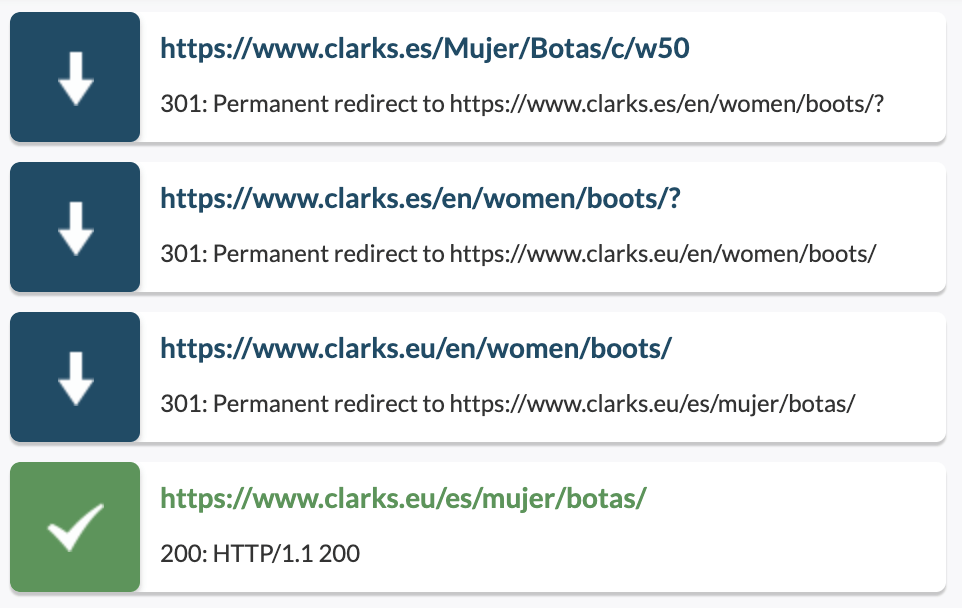
In these cases we can see that there is a chain of up to 4 or 5 hops, some of which are not very useful or can be avoided. To check this in bulk, we can use Screaming Frog, and identify thus where redirects of each market are pointing, using the Chrome browser as the user-agent:

To replicate it in the same manner, we’ve also added an “fr” language header, to simulate being users with this browser configuration.
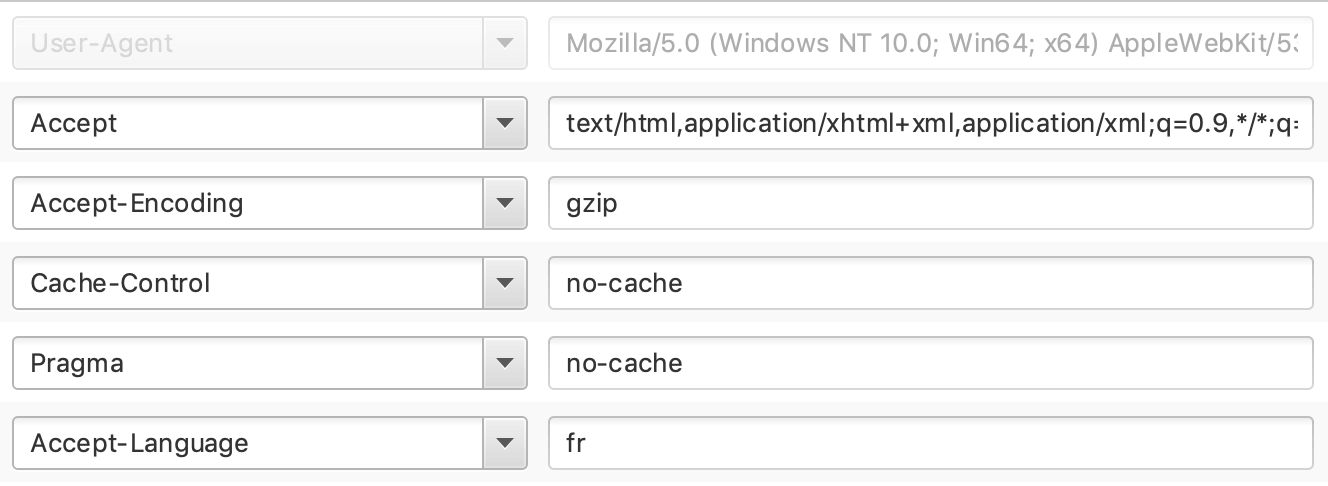
And this is the list of redirects which are finally landing on the French version of the website correctly, but passing by the /en/ version first.
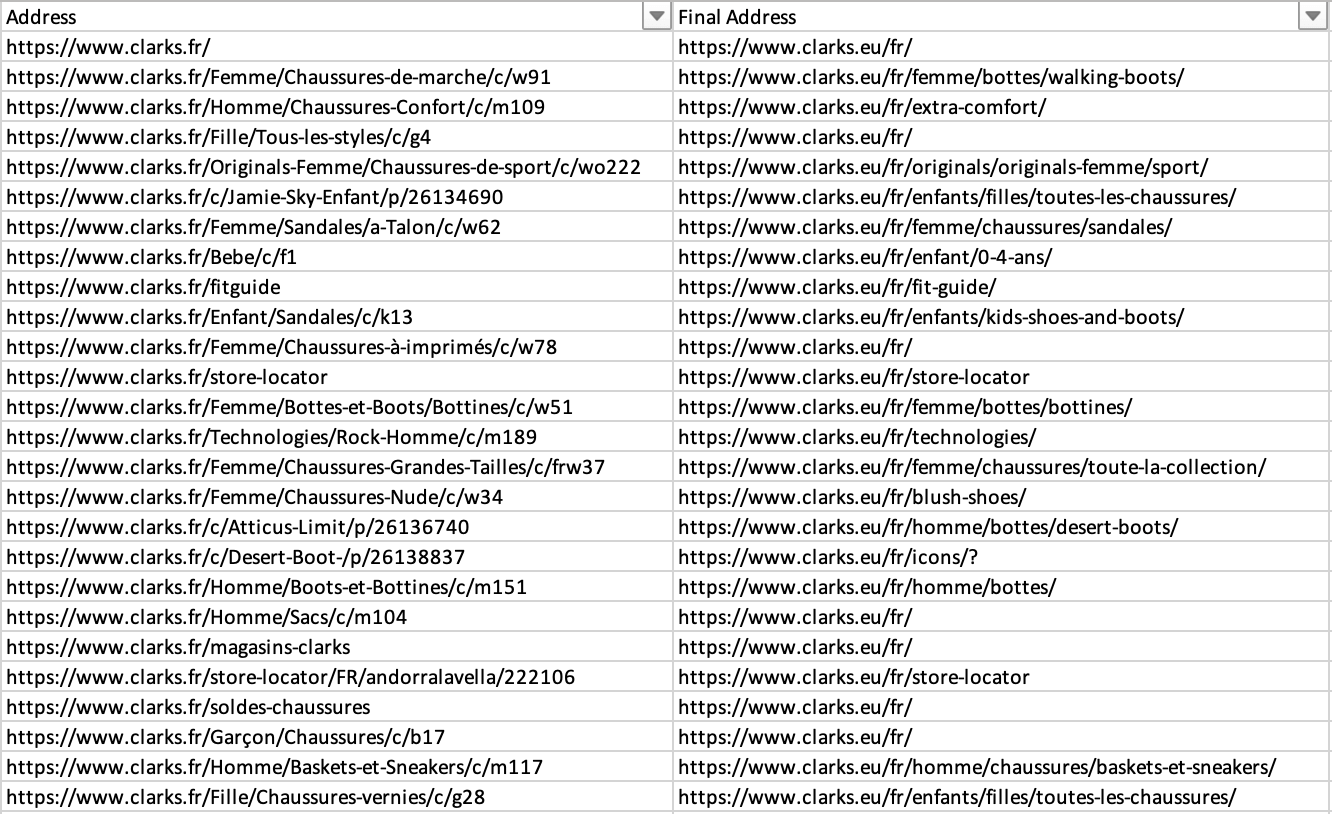
And what happens if we look at it through Google’s eyes? That it stays at the /en/ version. Now we must configure the user-agent as Googlebot or Googlebot Smartphone, to simulate what Google would see, without using the accept-language header. We see that the Spanish version redirects end up on the /en/ version:
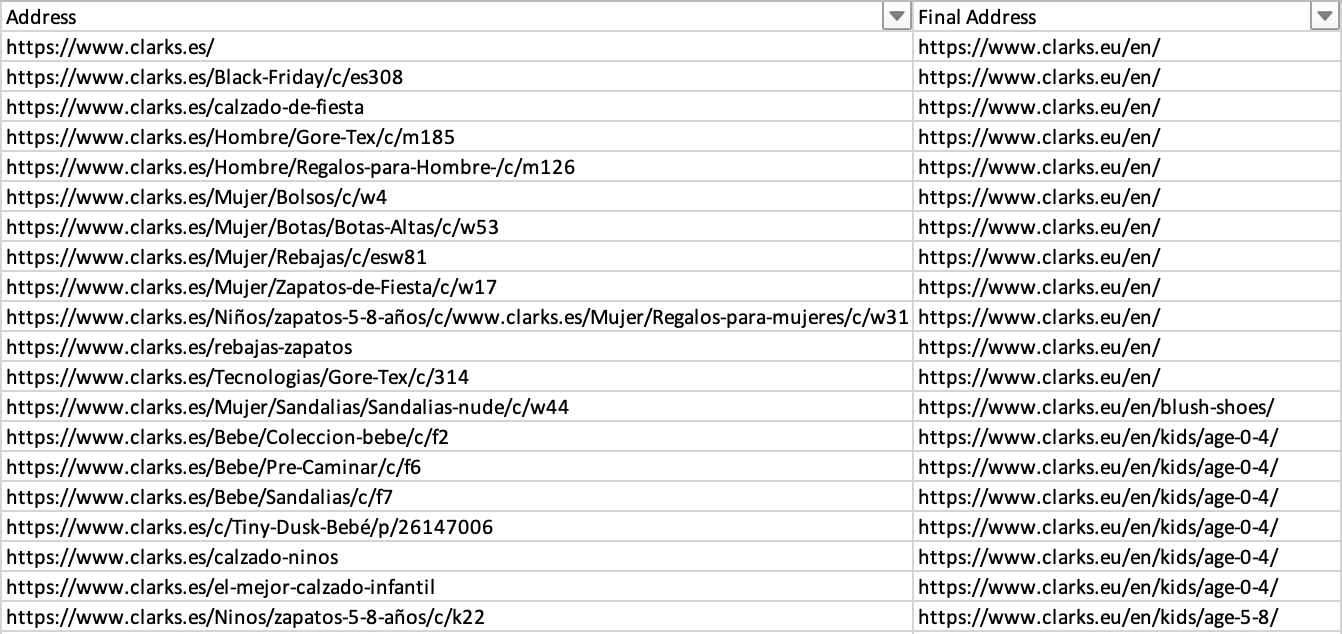
One of the possible causes behind this widespread loss could reside in this issue: clarks.eu’s local directories do not receive redirects or inherit any strength from its local sites, therefore we aren’t transferring any authority to its paths.
Another aspect we could consider is whether the target pages set for the redirects are the most suitable or not, and this could be another reason due to which we lose relevance after a migration.
For example, at the end of this table we see categories, subcategories and product pages, pointing to the same category of products for kids aged 0-4. Nevertheless, if these URLs do not exist on the new website, but we want to preserve their rankings, links or traffic, we could consider this to be a good idea.
In a migration we risk losing all previously acquired visibility, so we must strive to redirect URLs with rankings, traffic and external links, as well as all indexed pages we want to preserve.
According to any best SEO practice handbook, we would have to use single-hop 301 redirects, for achieving the most effective authority transfer to the target page. We should also focus on making the target page receiving the redirect as relevant as possible, to prevent relevance losses and Google no longer thinking of us as the best possible answer to the user’s query.
Platform change to Salesforce
Moving to another content platform is often a very significant change, as each CMS manages websites in a different way, and is subject to different settings.
What unintended problems does clarks.eu suffer from with its move to Salesforce Commerce Cloud (Demandware)? We’ve identified the existence of issues with regard to canonical tags, as there are sensitive aspects we must keep in consideration when using Salesforce, and we’ve grouped them into these 3:
- Products with different colours and different URLs. We use the canonical tag to set one page as the original one, and point the remaining pages to it.
For example, this product is available in 12 colours:
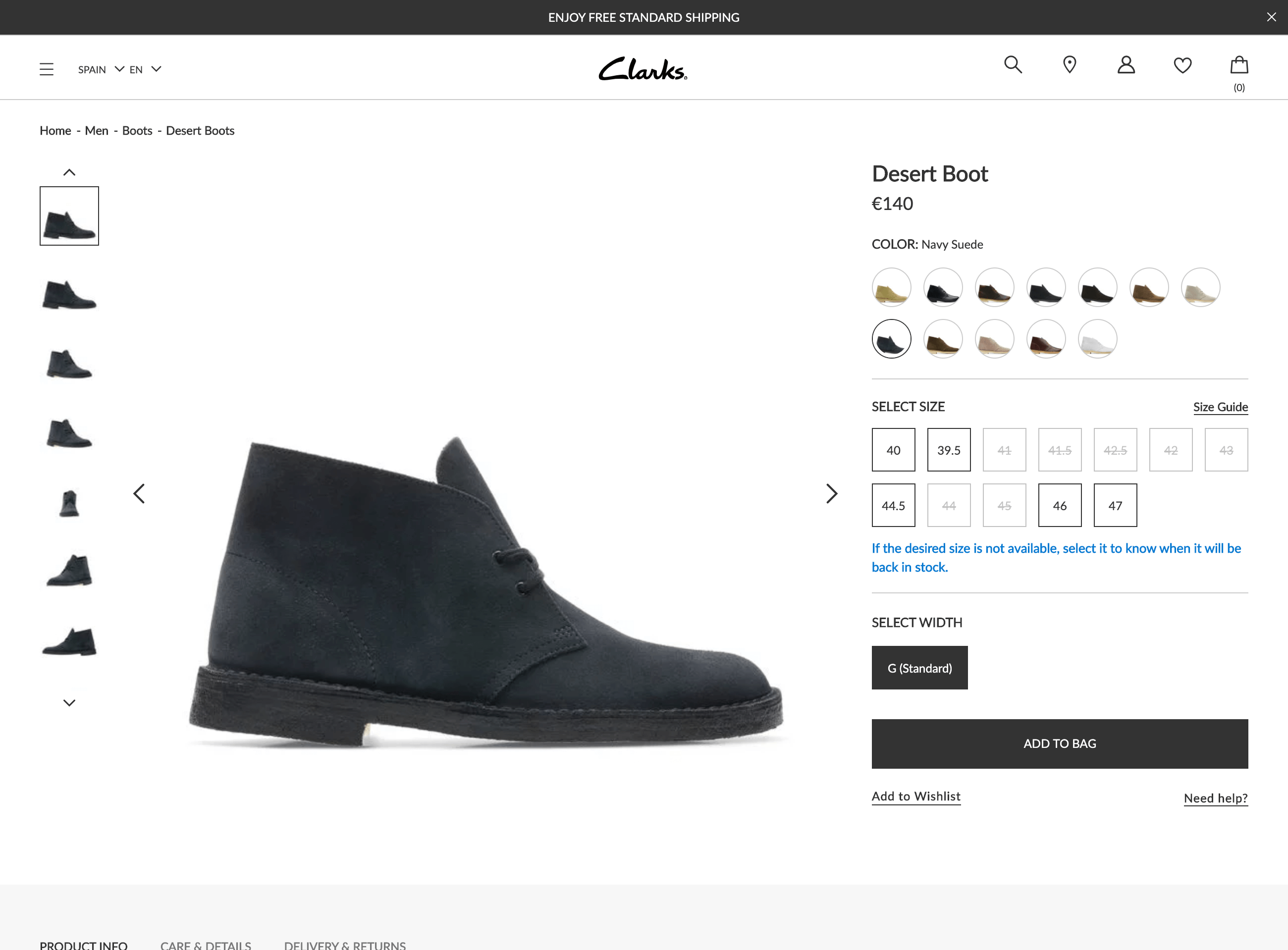
Therefore, 12 almost identical URLs with minimal differences are generated.

Canonicals are used to point them to the product considered to be the original one, which we want to index and rank.
While this is the correct approach, at this point we should consider the possibility of having one product for each URL, and features that aren’t susceptible to being searched on Google, should be loaded dynamically on the product page, to prevent the generation of too many URLs and dealing with crawl budget, internal links and cannibalisation inefficiencies, amongst other issues.
- Parameter management: canonicals are used to favour parameter-less URLs.
- Internal pages generating loops, by pointing with a canonical tag to a URL redirecting itself.
We’re going to illustrate this with just one unique self-explanatory example. Look at the following URL, and the canonical tag seen in the header.
URL: https://www.clarks.eu/es/mujer/colecci%C3%B3n/ancho-especial/ <link rel="canonical" href="https://www.clarks.eu/on/demandware.store/Sites-clarks-Site/es/Search-Show?cgid=women-collections-wide%20fit" />
However, the URL appearing in the canonical tag redirects again to the original URL:
https://www.clarks.eu/es/mujer/colecci%C3%B3n/ancho-especial/
This isn’t an issue we see widely repeated on the domain, but all these details, on their own, end up affecting the signals sent by the website.
In all three cases we have an additional handicap: internal linking. URLs with a canonical tag pointing to another URL are still available (200 OK), so they continue being linked from within the structure, and this issue in and of itself already creates a contradiction and sends mixed SEO signals to Google.
Here’s an example:

The following aspects should be carefully considered in terms of SEO when using Salesforce Commerce Cloud:
- – Duplicate categories may appear with parameters such as ?viewAll=true
- – Faceted navigation or filters generate concatenating parameters (prefv1) and can multiply available URLs, thus resulting in crawling and indexing issues. They can also be customised, and block or exclude any parameters we see fit.
- – Internal URLs of the CMS being linked can generate thin and duplicate content (/on/demanware.store/), including the 404 error page.
- – Management of identical product URLs, with variations in colour or other features. Massive amounts of URLs can be generated as a result of catalogues with a certain size, which carry products presenting a wide range of features. Thorough management of canonicals and noindex will be fundamental, and internal link optimisation will depend on it.
Use of Hreflang
With Clarks being an international project, this change is a good opportunity to sort the results displayed in each search engine. Therefore, as a result of the migration, hreflang tagging has been included, and although to this day not much has changed, all digital assets of Clarks are susceptible to rank for branded queries:
Now that clarks.eu is already using hreflang, we can identify aspects which could be negatively affecting Google’s ability to understand its tagging correctly using the Optimizer, and apply fixes for the purpose of disambiguation of the results:
- Hreflang tags not pointing to the canonical URL

- Hreflang tags missing a self-referential canonical

- URLs missing hreflang reverse links.

- Hreflang X-default is not set

Symptoms of this problem can be identified by observing whether in Spain, France, Italy or Germany we encounter URL rankings which do not match their target market. This can be easily checked with the Keyword report, where we’ll set a filter URL > Does not contain the text and enter the local directory.
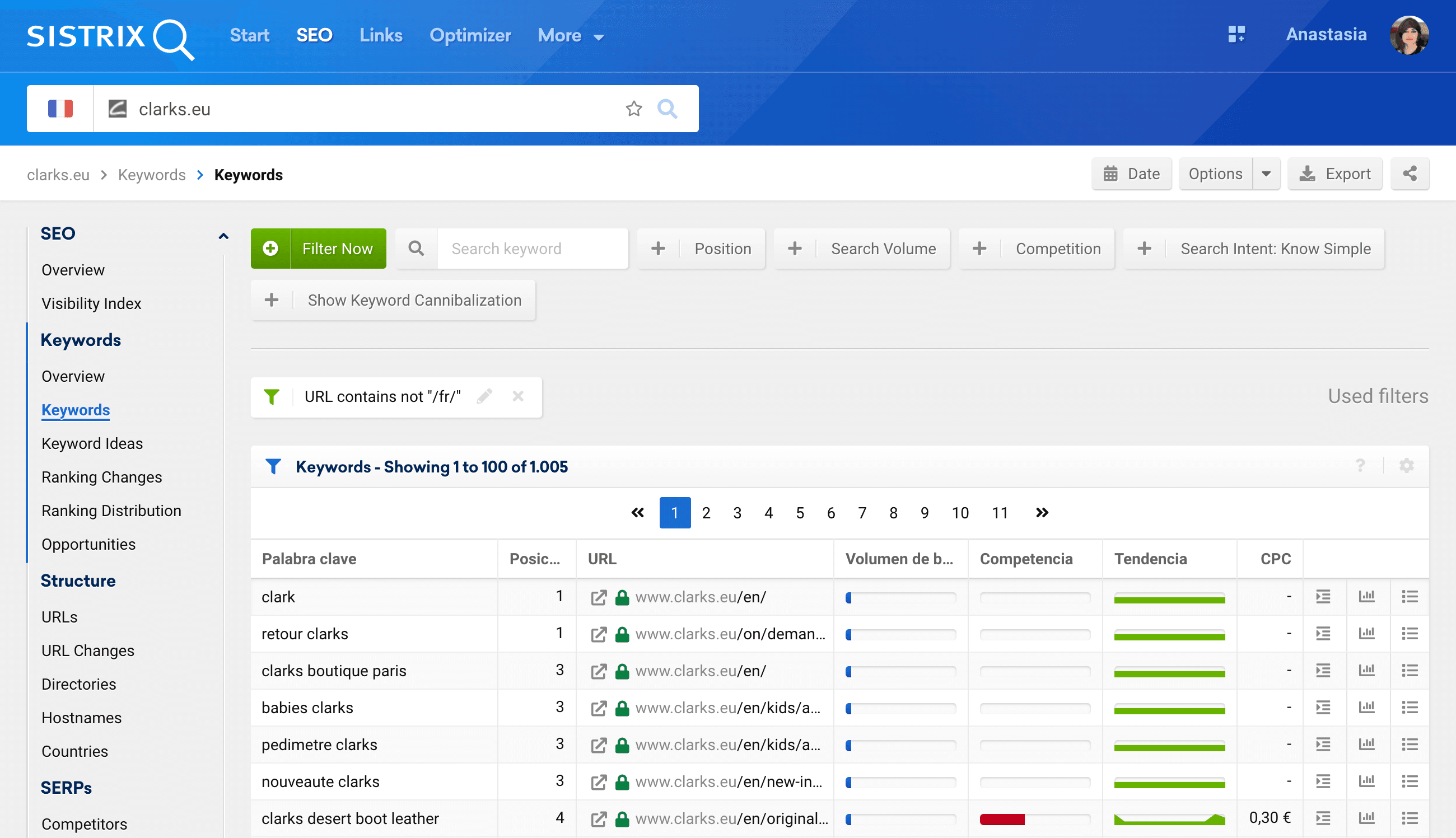
Now, we are able to see that 61% of keywords rank with URLs belonging to other markets, while in France it goes up to 68%, in Italy to 62%, and in Germany to 64%.
With a correct tagging and Google re-crawling the website these numbers should gradually decrease, making it an interesting metric to keep track of in order to check whether it’s progressing well or not.
Loss of external links
Maintaining and transferring the popularity gained by the ccTLD is vital in order for the new directories inside the gTLD to keep flourishing.
Using our “Broken Links” feature we have identified that all 4 domains analysed in this post have lost links, as target URLs have not been redirected.
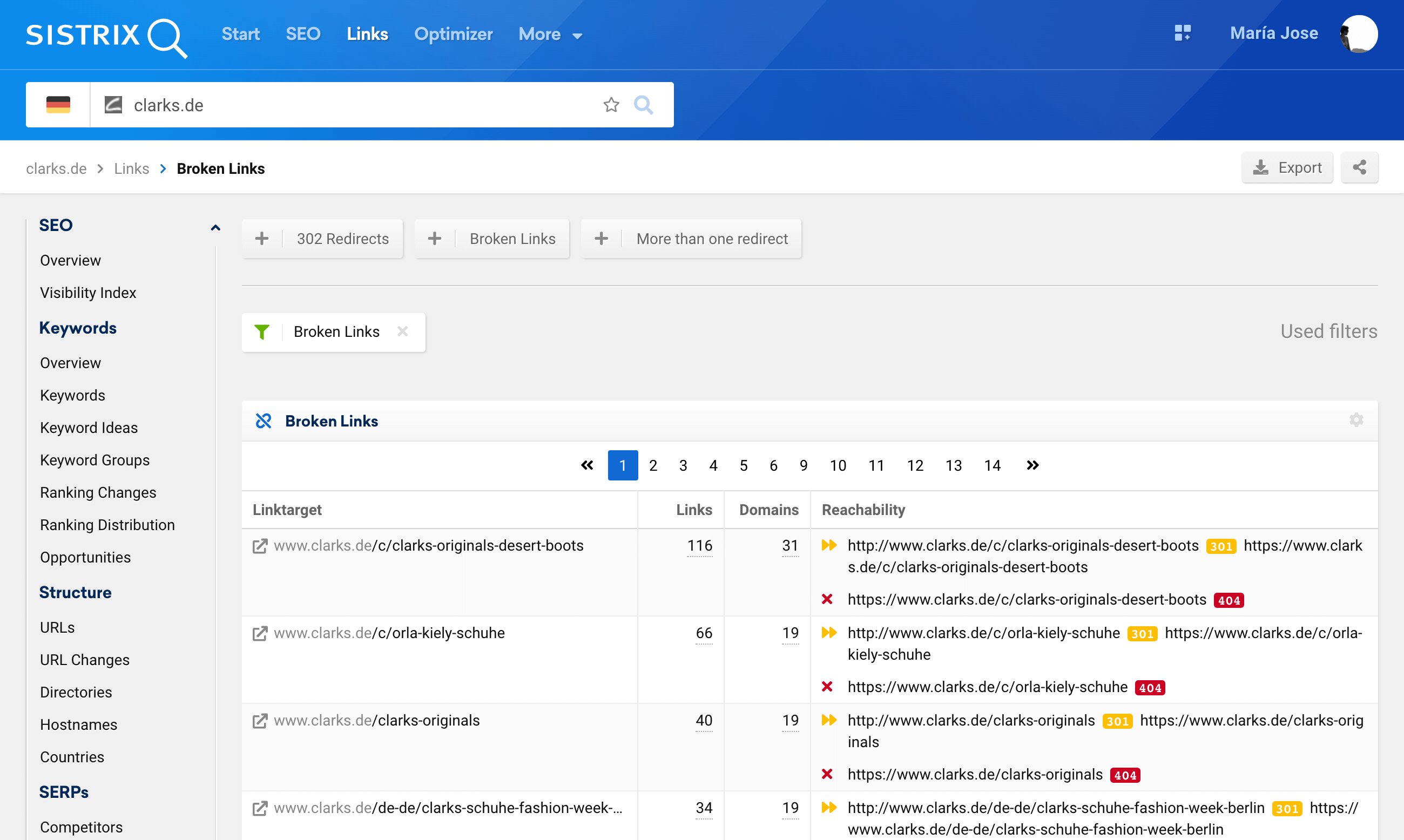
If we count the links lost by the four domains, we can see that this loss is rather significant.
| Links | Domains | |
|---|---|---|
| clarks.es | 2416 | 362 |
| clarks.fr | 1148 | 421 |
| clarks.de | 2757 | 1075 |
| clarks.it | 312 | 166 |
If we can contact the domains linking the previous version, or we’ve conducted communication strategies and we’re in a position to request changes, it will be a good idea to do so, although the fastest solution would be to redirect these URLs to their closest match on the new website.
Other changes: design, layout, and on-page elements
With regard to structure, content, layout and on-page elements it’s crucial that we try not to remove important links, resulting in orphaned or inaccessible pages, for both bots and users. We must also respect the html structure of each page type (categories, product pages, and static pages). Last, but not least, we must not forget that we live in a mobile world, meaning navigation and design must be adapted to being used on mobile devices.
If we look at the German version of the brand, there’s a small reduction in content and various links leading to other similar sections, mainly in product categories.
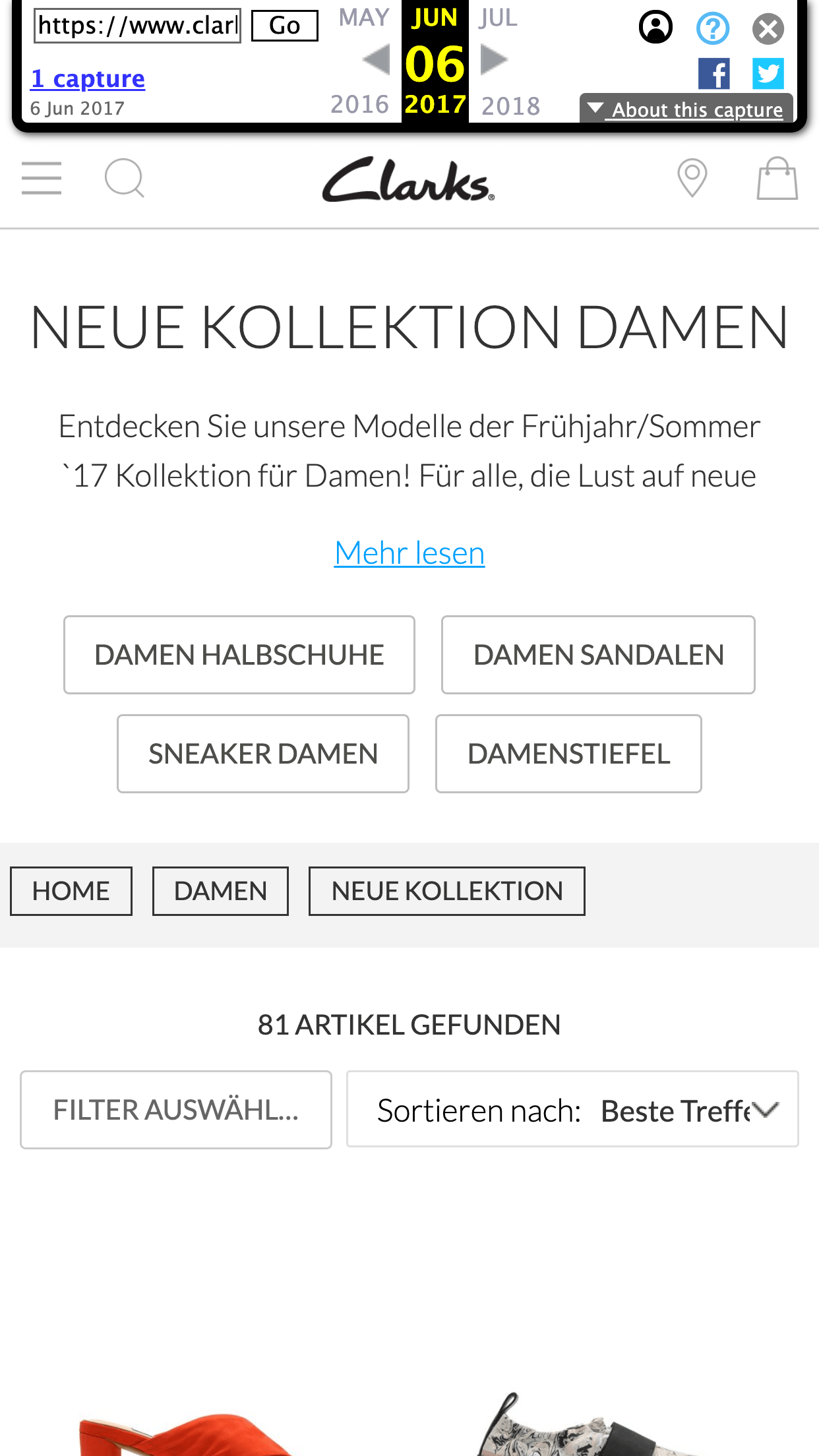
We haven’t observed any additional structural changes worth mentioning, or any other things that would make us think that the visibility loss is somehow related to this. It’s true, however, that the redesign has refined and stylised the website’s appearance, at a purely ecommerce level, with improved product pages, and product categories also showing UX and CRO improvements in terms of filtering.
Conclusions and lessons learned
Based on our post about migrations, we can summarise the aspects to keep in mind when conducting a content move:
- Too many changes all at the same time.
- Domains can transfer penalties.
- Mistakes when communicating a rebranding.
- The project’s trend can be preserved after migration.
You’re probably wondering: can you come out victorious after a change of such magnitude?
This project has made a difficult decision grouping all the European countries onto the same website, with all the risks it entails. We don’t know the reason behind it, so we’re not going to try and wrap our head around this as to “why”. We can, though, reflect on the “how” it’s been done, for learning purposes.
- To guarantee visibility continuity and the project’s progress, it’s necessary to define a strategy and strictly follow the planning .
- When moving from local websites to a single website with subfolders for each market, it’s important to ensure a correct authority transfer and popularity flow towards the new URLs, to prevent visibility loss, and that all URLs point to one unique market (in this case, the /en/ directory). If you check your logs and Google keeps going to the local websites, you can still modify the redirects and recover part of the visibility.
- When launching or redesigning the new website, it’s important to ensure that its structure, content and main SEO guidelines are not dramatically different to the previous version, and if they are, they have been tested beforehand to mitigate their risk. In this case, it can be extremely helpful to know the pros and cons of Salesforce in terms of SEO, and develop ad-hoc strategies before the migration.
- We can remove obsolete content or URLs, but we must send consistent SEO signals, especially with regard to crawling, indexing and canonicalisation.
Perhaps Brexit can explain this move, as the United Kingdom’s exit from the European Union was officially set for 31 January 2020 (although the transitional period will last until the end of 2020). It’s possible this event increased the urgency for the migration, despite the fact that the Italian site registers its first drop during the first week of February, and not at the end of January. These are nothing but assumptions, and the real motives behind this are only known to Clarks.
We would like to finish this article saying that no two migrations are alike, because each project has its own context and different settings: times for planning, execution and tracking; priority queue of the IT, marketing and product departments… Such a move requires getting a lot of different people to reach an agreement, as well as other unforeseen complications.
And no, this is not an easy migration. On many occasions there isn’t enough time, there aren’t enough resources, and there are other business priorities prevailing over SEO; and maybe, it was just done this way because it wasn’t thoroughly thought out.
In the case of Clarks, it shouldn’t prove too difficult to recover their previous rhythm, by solving the primary issues related to visibility loss, especially if the response is carried out swiftly and there’s a prompt reaction time, as Google is probably still re-crawling all the websites.
You can assess live data from all domains and grow your visibility with the Free SISTRIX Trial.
